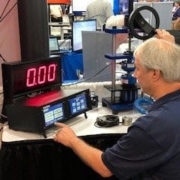Heavy Truck Test and Measurement Solutions
 Interface is a trusted supplier to the vehicle industry. Manufacturers of vehicles and components rely on our sensor technologies for measuring force, torque, and weight. In the vehicle subsector of trucks, there are three main classifications of this type of vehicle based on weight: light, medium and heavy trucks, sometimes called heavy-duty.
Interface is a trusted supplier to the vehicle industry. Manufacturers of vehicles and components rely on our sensor technologies for measuring force, torque, and weight. In the vehicle subsector of trucks, there are three main classifications of this type of vehicle based on weight: light, medium and heavy trucks, sometimes called heavy-duty.
Interface devices are commonly used in heavy-duty truck design and testing for various purposes, from structural to aerodynamic testing. Manufacturers use our load cells, torque transducers and instrumentation in testing labs to ensure vehicles meet regulatory and performance standards. Component and parts makers utilize our sensors and instrumentation for research, design, development and production, whether they are making brake pedals or tires.
Heavy Duty Truck Test and Measurement
- Structural Testing: Interface products are used to evaluate the structural integrity and performance of truck components and systems. Load cells may be installed at critical points such as suspension mounts, chassis connections, and body attachments to measure forces and stresses experienced during static or dynamic testing. This helps engineers understand the load distribution, identify weak points, and optimize the design for enhanced durability.
- Brake System Testing: Force measurement devices play a crucial role in assessing the performance and efficiency of a truck’s braking system. Load cells are commonly employed to measure the forces exerted on the brake pedal during braking maneuvers. This data helps evaluate braking performance, optimize braking force distribution, and ensure compliance with safety standards. Wireless load cells are growing in use for these types of tests. See: WTS Brake Pedal Force Testing
- Tow and Haul Assessments: Determining a heavy-duty truck’s towing and hauling capabilities requires measuring the forces. Interface measurement devices are used to quantify the forces experienced by the vehicle during towing or hauling tasks. Load cells installed at key attachment points, such as trailer hitches or cargo beds, are used to measure the forces applied under different loads. This data aids in establishing safe operating limits and optimizing the truck’s design for maximum payload capacity.
- Suspension Testing: Strain gage based sensors are frequently utilized to evaluate the performance of a truck’s suspension system and its impact on ride comfort. Load cells or accelerometers may be used to measure forces, vibrations, and accelerations experienced by the vehicle under various road conditions. This helps engineers optimize suspension settings, tune shock absorbers, and design suspension components that provide a balance between load-carrying capacity and ride quality.
- Crash Testing: High-accuracy load cells and instrumentation are integral to crash testing heavy-duty trucks to evaluate occupant safety and structural integrity. Sensors are used to measure impact forces, accelerations, and deformations during controlled crash simulations. This data helps engineers assess the effectiveness of safety features, such as crumple zones and restraint systems, and improve the truck’s crashworthiness. Read: Vehicle Crash Test Load Cell Wall
- Aerodynamic Testing: Measurement tools are employed to assess the aerodynamic performance of heavy-duty trucks. Load cells and systems used to measure the forces acting on the vehicle’s body, including drag and lift forces helps optimize the truck’s shape, reduce aerodynamic resistance, and improve fuel efficiency.
Another force that Interface has a great deal of experience measuring and helping our customers to monitor is load pulled or hoisted by components attached to trucks or other heavy machinery. As an example, Interface can measure the load capacity of a truck hitch to test the maximum capacity of an object it is pulling. It can also monitor the hitch in real time to ensure the load combined with the velocity of the vehicle or the gradient of a roadway is not creating a risk of failure.
In addition to testing the vehicles, safety standards exist for large, long and short haul trucks regarding their weight limits for most highway systems. It is why you often see weigh stations across the highway on road trips. Force sensors are often used in these types of weigh stations due to our product’s high capacities, accuracy, and reliability. Adversely, we also measure these types of vehicles capacity prior to hitting the open road to ensure the vehicle is designed to manage the amount of load in transport.
Suspension Testing for Heavy Duty Trucks
It is important to heavy duty track manufacturers to thoroughly test suspension. Automotive suspensions require fine tuning for best performance on various roads and conditions. Simulation of bumps, banking and other road conditions result in off-axis loading. Interface’s 1200-series load cell were mounted on top of each post in a 4-, 5-, or 7-post rig, which allowed them to measure forces during simulated driving. Moment compensating design of 1200-series load cells provide accurate readings during off-axis loading. This solution provides highly accurate (0.04%) measurement of loads applied to individual suspension points.
Truck Weighbridge
A customer owns a truck company and needs to record the weight or loads being carried by their trucks. They would like a wireless weighing bridge that is able to transmit, log, and display the results in real time. Interface suggested installing multiple WTS 1200 LowProfile™ Load Cells under a weighing bridge. When the truck drove over it, the load cells transmitted the force results wirelessly to the WTS-BS-4 Industrial Base Station connected to the customer’s PC with provided Log100 software. The WTS-LD2 Wireless Large LED Display also displayed the weight inside for the driver to see in real time. Using this solution, the customer was able to measure, log, and graph the different loads their trucks carried wirelessly onto the weighbridge with success.
Tire Testing for Semi-Trailers
A typical semi-trailer truck consists of a tractor unit with two front wheels and two sets of tandem axles at the rear, each with two wheels, resulting in a total of 18 wheels. By trade, 60,000-pound trailers needed at least three axles and 12 tires. Testing tires and mounting requires precision for these vehicles that are responsible for trucking goods and materials across the interstates and highways. A tire production company wants to put their tires under a stress test to research the dynamic control capabilities of their tires. Interface suggests using the AT105 Contactless Force and Torque Transducer to measure both the lateral force and torque of the tired being tested. Torque and force results can be displayed and graphed when connected to the SI-USB4 4 Channel USB Interface Module. After conducting a stress test on their tires, the tire production company was able to record and log the measurements of the torque and lateral forces implemented on their tires.
These are just a few examples of the types of test and monitoring solutions provides for trucks and other heavy duty vehicles. To learn more about our sensor’s capabilities in the automotive test and measurement markets, visit Automotive and Vehicle Solutions.
ADDITIONAL RESOURCES
Garbage Truck On-Board Weighing App Note
Electric Vehicle Structural Battery Testing
Torque Measurement for Electric Vehicles







